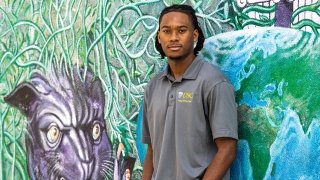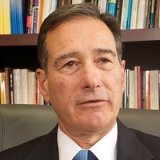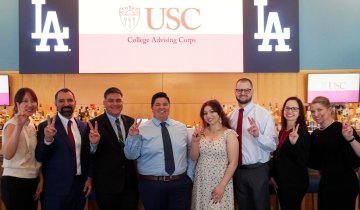Gerrel Sayles’ metallic-gold Nikes catch the sunlight as he walks the path to the career center at David Starr Jordan High School in Long Beach, Calif.
Fancy footwear is more than a fashion statement to Sayles. It’s a tool (bait, really) for funneling low‐income, first‐generation, underrepresented students into the college pipeline.
“A lot of my students wear nice shoes,” explains Sayles, an avowed sneakerhead. “We talk about shoes, then start talking about other things. It opens up. I might see them on campus and say, ‘Hey, are you going to get those new Air Jordans?’ And they may say, ‘I don’t know, I spent a lot of money over Christmas.’ Then we start talking about financial aid.”
Sayles, 22, is a first-year adviser in the USC College Advising Corps (CAC).
Based in USC Rossier’s Center for Enrollment Research, Policy and Practice (CERPP), the program addresses head-on the dearth of college-guidance services for students in the region’s most underserved schools. Now in its seventh year at USC, CAC places passionate, high-quality college advisers directly in the schools.
“It is not only the work they do but they themselves who give us great hope for the future,” CERPP Executive Director Jerry Lucido says of corps advisers like Sayles. By devoting two years of their lives to CAC, they act out an “abiding belief in education and equity,” he says.
Corps advisers, who are USC employees, receive an entry-level salary plus full employee benefits. CAC Program Director Ara Arzumanian calls it a hybrid service-learning and career-building experience. When Sayles—who graduated from California State University, Long Beach (CSULB), last May—finishes his two-year stint, he will have racked up hundreds of hours in the booming college advising and youth-development field by overseeing the college-access process for about 1,000 students.
Recruited straight out of college, incoming advisers enter a four-week summer bootcamp where they’re immersed in the technical aspects of college research, applications, financial aid and enrollment. They’ll master the soft skills that work best with underserved youths and their parents, teachers and school administrators. And they’ll learn to track the youths’ progress and analyze results.
“I tell them when they’re getting started that this is going to be one of the most challenging but also most rewarding and fun experiences of their lives,” Arzumanian says. “They usually tell me by the end of two years that this was a very accurate description.”
CAC’s recruitment process is highly selective. Last March, nearly 400 candidates interviewed for just 25 first-year corps adviser openings.
Sayles was one of the select few to make the cut.
INSIDE THE CAREER CENTER, Sayles is softly streaming hip-hop through the Bluetooth speaker on his desk. It’s one of two desks facing rows of computer workstations where students dutifully create logins for college admissions portals, compose personal statements and fill out financial aid forms.
The other front desk belongs to second-year corps adviser Stacy Anguiano, a Compton native who graduated from Cal State Northridge in 2018. This is Anguiano’s third year at Jordan High. As a senior majoring in sociology with a minor in child development, she’d worked there part time as a college adviser for Educational Talent Search (ETS). But the cohort-style program capped her caseload at 60 students and came with restrictions she found troubling.
“I didn’t like the limitation of not being able to work with undocumented students because ETS is a federally funded program,” she says. “I wanted to try something where I can work with all students, and USC CAC allowed me to do that.”
Standing nearby, Sayles assists Mayra, who is creating a portal account on the Long Beach City College site. He guides her through the steps, checking the school code on his cellphone.
Imani waits his turn. He has already finished his college apps and financial aid forms. He’s hanging out at the career center because he has a free period, and Sayles agreed to help with his economics homework.
They share a passion for basketball. Sayles used to play varsity basketball at nearby Lakewood High School, and he participated in intramural, coed and open leagues throughout college at CSULB.
Imani is on the Jordan Panthers varsity team and has received nibbles from a recruiter at the University of Illinois. His college list also includes Tuskegee University, CSULB and several local community college “safety” schools.
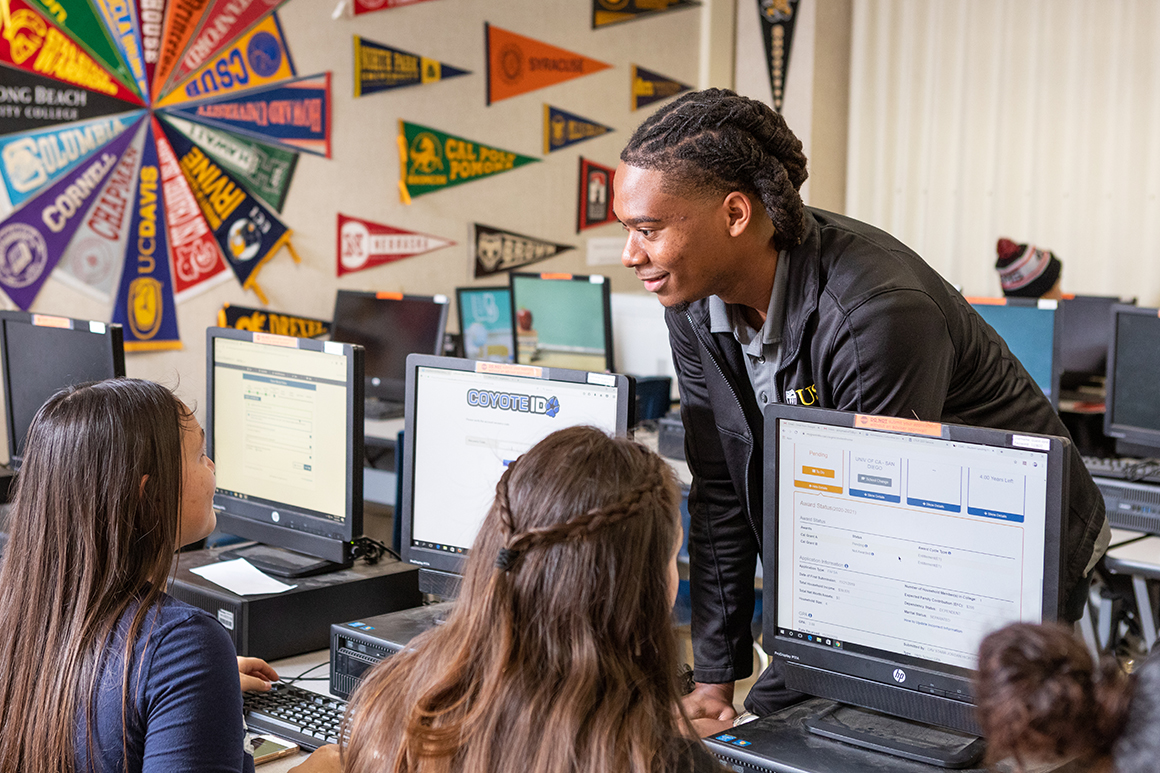
IT'S NO ACCIDENT that corps advisers are chosen from recent college graduates—near-peers, in program lingo.
In Sayles’ first week on the job, Jordan High security guards kept stopping to ask for his hall pass as he made his way to classroom presentations.
“I think it’s a good thing that I look young because the students come and talk to me about random things. Sometimes I have to tell them, ‘Hey, roll it in a little bit. Have a level of respect,’” he says.
As authentic role models, Sayles and Anguiano are living proof that a college education is attainable for their advisees—young people just like them.
College and career specialist Marquesa Lawrence-Wells is one of three Long Beach Unified School District staffers who work alongside the two corps advisers in Jordan High’s career center. After 12 years on the job, Lawrence-Wells has seen the power of the near-peer formula.
“The kids become very attached. If Gerrel and Stacy are not here, they don’t even want to talk to me,” she says, only half-joking. “Their age counts. Their just having finished college counts. Stacy and Gerrel are first-generation, so they’re able to meet the students where they are—because nobody really understands the mental part of being a first-generation college student like they do.”
“She told me that college is not a dream, it’s a reality.”—Gerrel Sayles, first-year adviser in the USC College Advising Corps
BORN AND RAISED in Long Beach, Sayles graduated from Lakewood High in 2015. His mom works in the cafeteria at nearby Jane Addams Elementary; his stepdad works on a maintenance crew for the City of Long Beach.
A successful student, Sayles was holding down a 3.25 GPA as a senior. Still, going to college seemed unimaginable. The aha moment came when he met Cynthia Le MEd ’19, Lakewood High’s first USC CAC adviser.
“She told me that college is not a dream, it’s a reality, and that I was eligible for lots of schools,” Sayles recalls. “After that, I would be there every morning, asking her, ‘What do I need to do? You need me to write a personal statement? How do I pay for this? Are there scholarships?’”
Le recognized that Sayles was exceptional. When she gave him feedback on his application essays, he came back the next day with revisions. Other students took weeks or months to return.
“He’d get to school earlier than me,” she recalls. “I would show up at my office, and Gerrel would be sitting outside waiting for me.” Soon he was bringing his friends.
The two stayed in touch while Sayles earned his bachelor’s degree in sociology. Then last spring, when Sayles reached out to ask about becoming a USC CAC adviser, Le put him in touch with program recruiters and gave him a glowing endorsement.
Now, he’s following in her footsteps.
USC CAC started in 2013 with three advisers. In just six years, the corps has grown to 44 advisers working full-time at 39 Title 1 schools across eight Los Angeles County districts: Alhambra, Compton, Downey, El Monte, Long Beach, Los Angeles, Lynwood and West Covina. Last year, they collectively held nearly 46,000 one-on-one meetings with seniors. Those interactions directly led to nearly 39,000 college applications filed and about 11,000 Free Application for Federal Student Aid (FAFSA) submissions.
More than 10,000 (from a pool of 16,000 seniors at the 39 partner schools) ended up submitting at least one college application and were accepted into at least one school.
According to the 2019 CAC impact report, seniors who met with a corps adviser were 18 percent more likely to apply to at least one college, 19 percent more likely to submit the FAFSA and 20 percent more likely to apply for scholarships.
Beyond the metrics of direct impact, corps advisers’ full-time campus presence has profound ripple effects.
They boost their school’s overall college-going culture. Last year, the 44 advisers organized 5,700 school visits by college admission reps and arranged 1,000 college campus tours for their advisees. They regularly engage in parent education, host FAFSA workshops and build excitement around College Decision Day.
Despite its 88 percent graduation rate and “Best U.S. High School” ranking in U.S. News & World Report, Jordan High faces big hurdles. According to the School Accountability Report Card, 11 percent of its current students are homeless, and 20 percent are English learners. Only 48 percent of students meet the minimum admission requirements for California four-year colleges, and 87 percent are economically disadvantaged.
“With our kids, it’s not, ‘Here are the directions, now do it,’” Lawrence-Wells says. “It’s almost to the point of, ‘You deserve to go to college. You’re worth going to college!’ You have to sit next to them and convince them, even though they’re eligible.”
65 percent of new jobs in the economy [require] postsecondary education and with virtually all student growth coming from low-income, first-generation populations, our advising corps contributes directly to the future of our democracy.”—Jerry Lucido, Executive Director of CERPP
A 2016 SURVEY conducted by Phi Delta Kappa International asked how a hypothetical influx of funds would best be spent to improve public schools. Counselors came in dead last, with just 6 percent of the popular vote. Teachers, supplies, classes and extracurriculars, infrastructure and new schools were all deemed more important.
Meanwhile, the American School Counselor Association recommends a student-to-counselor ratio of 250:1. The national average is 442:1. In California, it’s 644:1.
“We have a system of higher education that provides an outsized advantage to those with wealth,” says CERPP’s Lucido. “Students who are fortunate enough to attend well-resourced schools, have college-educated and experienced parents, and have sophisticated college counselors, have a dramatic leg up when it comes to attending and graduating from college. With 65 percent of new jobs in the economy requiring postsecondary education and with virtually all student growth coming from low-income, first-generation populations, our advising corps contributes directly to the future of our democracy.”
Seventy years ago, the Truman Commission Report called for massive expansion of postsecondary education opportunities with the goal of buttressing American democracy. Today, college access lies at the heart of a new movement to do the same.
A 2002 longitudinal survey showed that Hispanic students were much less likely to attend college than other groups. Since then, their participation level has improved dramatically. As a predicted college enrollment crisis approaches, a growing percentage of high-school graduates will be Hispanic. At Jordan, they make up 77 percent of the student body.
The downstream effects of sending first-gen students to college are powerful. Children of college graduates are far more likely to pursue postsecondary education and aim for top schools, Harvard Business Review director Justin Fox notes in a Bloomberg column.
A generation from now, the students whom CAC advisers steer to college today will have children of their own who, hopefully, won’t need their services.
A TABLE BY THE WALL in the career center has two bins filled with more than 500 hanging folders—one for each graduating senior they’ve met with, arranged in alphabetical order. Inside each folder is their login information for every portal and their complete academic record. Sayles and Anguiano have succeeded in connecting with 94 per cent of the school’s seniors. As of mid-January, 25 of Jordan’s 530 graduating seniors have failed to submit any college applications. The corps advisers visited their classrooms, connected with their teachers and school counselors, reached out by email and phone. To no avail.
Still, should any of the stragglers wander in, there’s a binder with their academic records standing by.
Corps advisers track each student interaction through a proprietary database. They keep careful records of each college application completed, each acceptance, rejection or waitlist received. They monitor progress on financial aid form status. They keep charts of students organized by their membership in learning communities and cross-tabulated by their GPAs, college choices and admission status. They share these records with academic counselors to keep them in the loop.
It’s labor-intensive but important work.
Once advisees leave high school, CAC continues to track their college enrollment, persistence and graduation. The data is integrated with information from the National Student Clearinghouse and other publicly available data sources, vetted by independent auditors and shared with all CAC partner institutions.
USC CAC belongs to a network of 29 universities that partner with the nonprofit College Advising Corps. Founded in 2005 and headquartered at the University of Virginia, the umbrella organization provides seed grants covering 40 percent of partners’ program costs, with school districts providing the balance. The lion’s share—79 percent—goes to paying advisers’ wages.
Collectively, the 29 programs reached 200,000 students last year at 782 high schools in 17 states. The goal is to reach 1 million students by 2025, backed by a $20 million gift from philanthropist Connie Ballmer and her husband, former Microsoft CEO Steve Ballmer.
AS THE PROGRAM builds steam, an alumni network is evolving.
A large number of corps advisers (42 percent) go on to graduate school—several at USC Rossier—during or immediately after their two-year stint. As a result, many now work at colleges where current corps advisers are trying to place their students. Cynthia Le is just one of 11 corps alumni employed at USC. Others are now insiders across nine Los Angeles-area community colleges, four Cal State campuses and an array of other postsecondary institutions.
The connections they form go deep and cross cohorts.
“We train each other, like I trained Gerrel,” says Anguiano. “We all support each other. When one of us gets into grad school, we all say, ‘Congratulations!’ If someone gets engaged, we all celebrate. It’s not just a job. It feels like family.”
Corps alumni like Le, who is now assistant director of financial aid at USC, regularly return as expert presenters at the summer bootcamp and lead special workshops held every month at USC Rossier throughout the year. Le’s niche is the College Scholarship Services Profile and appeals. Another corps alum, now based at Scripps College, leads the FAFSA training.
“The corps helped me realize that I want to work in higher education,” says Le. “It’s what inspired me to pursue my master’s. I pretty much owe my current career to being a USC CAC adviser.”
Seniors who met with a corps adviser were 18 percent more likely to apply to at least one college.
THE WORK BRINGS ITS SHARE of disappointments. For Anguiano, it was an advisee last year who’d jumped through every hoop and was admitted to Cal State Dominguez Hills, only to learn in the summer that his admission had been rescinded. He’d called her, distraught. It turned out he’d allowed his spring semester grade in an art class to drop to a D.
“He didn’t think that counted,” she says with a sigh. As a result, he failed to meet his college admissions requirement for visual/performing arts.
That student ended up at community college, but he’s resolved to transfer to a Cal State campus, he tells Anguiano. She’s keeping her fingers crossed.
Sometimes the letdown is no one’s fault.
A grim-faced young man in a pale-blue hoodie walks into the career center. He makes eye contact with his corps adviser.
“How’s the rehab going?” Sayles asks.
Anthony shrugs.
Last summer, as a rising senior, Anthony was riding high. Named team captain of the Panthers football team, he was expected to line up at quarterback, receiver, running back, safety and special teams.
Instead, a knee injury sidelined him.
Jordan High’s star athlete is also an academic star, holding down a 3.5 GPA. He was aggressively being recruited by colleges.
“Until I got injured,” he mutters, dejected. Holding out his phone, Anthony scrolls through a list of 20 NCAA recruiters who have stopped calling.
He will be cleared to play again in April.
Looking beyond the disappointments, Sayles, Anguiano and Le take comfort in a shared passion for working with youths.
“I love engaging with the students,” says Sayles. “I love when they come to me to ask for help.” Though his career goals aren’t fully formed, Sayles knows this much: “I don’t see myself doing anything that’s not connected with youth. That is my passion and my purpose. Not just high school age, but 5 years and up.”
After a day of college advising, he moonlights as a basketball coach for the City of Long Beach’s rec program and volunteers with a travel youth league.
Le also volunteers in her spare time. She first became a mentor with the Pullias Center for Higher Education's Increasing Access via Mentoring (I AM) program at USC Rossier back when she was a corps adviser at Lakewood High. She continues to mentor a dozen kids through the Pullias Center through the Pullias I AM college-transition program.
Anguiano is applying to graduate programs in education counseling. As she looks ahead to leaving Jordan High School, she is filled with nostalgia.
“I definitely will miss this job. I love coming to work every day,” she says. “Seeing the students, just them saying ‘good morning.’ Or when they get accepted into schools they didn’t think they had potential for—that just brightens my day.”
In the fall, Anguiano will be gone and Sayles will be the senior corps adviser at Jordan High, which comes with more responsibilities. He’ll need to bring his first-year corps partner up to speed and step up as the point-person for new programs and collaborations with teachers and the administration.
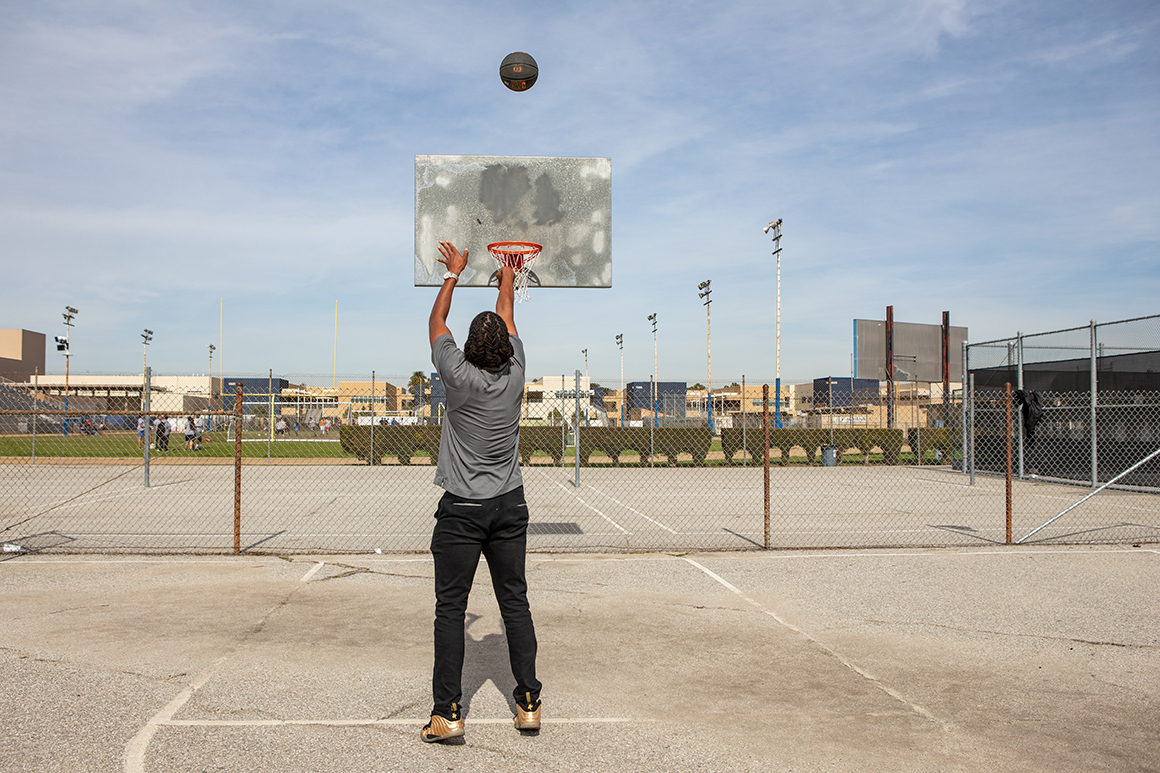
BACK IN THE CAREER CENTER, the computer terminals are filling up. Two students enter holding clusters of blue-and-silver helium balloons.
“Happy birthday!” Sayles greets them brightly.
Two Army recruiters dressed in camouflage come in, carrying pizza boxes. Sayles and Anguiano eat their slices at their desks.
“Gerrel and I have a really hard time taking lunch,” Anguiano admits, “because we know if we said, ‘Come back, we’re closed,’ we might not see that student again for a month.”
For breaks, she and Sayles take turns retreating to the teachers’ lounge to clear their heads.
As the lunchtime crowd subsides, Sayles walks across the room, his golden Nikes two bright spots on the carpet.
His face lights up as an advisee shows him a recent ceramics project.
“Oh, man. That’s amazing! You make that?” Sayles asks.
It’s a colorful, brightly glazed sculpture of a hightop sneaker.
“Can I have it?” Sayles asks jokingly.
Bashful, the student shakes his head and stows the ceramic shoe in his backpack.
A sneakerhead on a mission, Sayles grins as he makes his way back to his desk.

